Convection Inside Nanofluid Cavity with Mixed Partially Boundary Conditions
Abstract
:1. Introduction
2. Numerical Approach and Governing Equations
3. LBM Approach for Free Convection
4. Validation
5. Conclusions
Author Contributions
Funding
Institutional Review Board Statement
Informed Consent Statement
Data Availability Statement
Conflicts of Interest
References
- Khanafer, K.; Vafai, K.; Lightstone, M. Buoyancy-driven heat transfer enhancement in a two-dimensional enclosure utilizing nanofluid. Int. J. Heat Mass Transf. 2003, 46, 3639–3653. [Google Scholar] [CrossRef]
- Pourfattah, F.; Motamedian, M.; Sheikhzadeh, G.; Toghraie, D.; Akbari, O.A. The numerical investigation of angle of attack of inclined rectangular rib on the turbulent heat transfer of WaterAl2O3 nanofluid in a tube. Int. J. Mech. Sci. 2017, 131–132, 1106–1116. [Google Scholar] [CrossRef]
- Akbari, O.A.; Karimipour, A.; Toghraie, D.; Safaei, M.R.; Alipour, H.; Goodarzi, M.; Dahari, M. Investigation of rib’s height effect on heat transfer and flow parameters of laminar water–Al2O3 nanofluid in a two dimensional rib-microchannel. Appl. Math. Comput. 2016, 290, 135–153. [Google Scholar]
- Rezaei, O.; Akbari, O.A.; Marzban, A.; Toghraie, D.; Pourfattah, F.; Mashayekhi, R. The numerical investigation of heat transfer and pressure drop of turbulent flow in a triangular microchannel. Physica E 2017, 93, 179–189. [Google Scholar] [CrossRef]
- Karimipour, A.; Alipour, H.; Akbari, O.A.; Semiromi, D.T.; Esfe, M.H. Studying the effect of indentation on flow parameters and slow heat transfer of water-silver nano-fluid with varying volume fraction in a rectangular two-dimensional micro channel. Ind. J. Sci. Technol. 2016, 8, 51707. [Google Scholar] [CrossRef]
- Haddad, Z.; Oztop, H.F.; Abu-Nada, E.; Mataoui, A. A review on natural convective heat transfer of nanofluids. Renew. Sustain. Energy Rev. 2012, 16, 5363–5378. [Google Scholar] [CrossRef]
- Mashayekhi, R.; Khodabandeh, E.; Bahiraei, M.; Bahrami, L.; Toghraie, D.; Akbari, O.A. Application of a novel conical strip insert to improve the efficacy of water–Ag nanofluid for utilization in thermal systems: A two-phase simulation. Energy Convers. Manag. 2017, 151, 573–586. [Google Scholar] [CrossRef]
- Barnoon, P.; Toghraie, D. Numerical investigation of laminar flow and heat transfer of non-Newtonian nanofluid within a porous medium. Powder Tech. 2018, 325, 78–91. [Google Scholar] [CrossRef]
- Hakan, F.; Oztop, H.F.; Abu-Nada, E. Numerical study of natural convection in partially heated rectangular enclosures filled with nanofluids. Int. J. Heat Fluid Flow 2008, 29, 1326–1336. [Google Scholar]
- Mahmoodi, M.; Hashemi, S.M. Numerical study of natural convection of a nanofluid in C shaped enclosures. Int. J. Therm. Sci. 2012, 55, 76–89. [Google Scholar] [CrossRef]
- Guo, Z.; Zheng, C.; Shi, B. Discrete lattice effects on the forcing term in the lattice Boltzmann method. Phys. Rev. E 2002, 65, 046308. [Google Scholar] [CrossRef] [PubMed]
- Liu, Q.; He, Y.L. Lattice Boltzmann simulations of convection heat transfer in porous media. Phys. A Stat. Mech. Appl. 2017, 465, 742–753. [Google Scholar] [CrossRef]
- Chaabane, R.; Askri, F.; Ben Nasrallah, S. Parametric study of simultaneous transient conduction and radiation in a two-dimensional participating medium. Commun. Nonlinear Sci. Numer. Simul. 2011, 16, 4006–4020. [Google Scholar] [CrossRef]
- D’Orazio, A.; Karimipour, A.; Nezhad, A.H.; Shirani, E. Lattice Boltzmann Method with heat flux boundary condition applied to mixed convection in inclined lid driven cavity. Meccanica 2015, 50, 945–962. [Google Scholar] [CrossRef]
- Chaabane, R.; Askri, F.; Ben Nasrallah, S. Analysis of two-dimensional transient conduction-radiation problems in an anisotropically scattering participating enclosure using the lattice Boltzmann method and the control volume finite element method. J. Comput. Phys. Commun. 2011, 82, 1402–1413. [Google Scholar] [CrossRef]
- Goodarzi, M.; D’Orazio, A.; Keshavarzi, A.; Mousavi, S.; Karimipour, A. Develop the nano scale method of lattice Boltzmann to predict the fluid flow and heat transfer of air in the inclined lid driven cavity with a large heat source inside, Two case studies: Pure natural convection & mixed convection. Phys. A Stat. Mech. Appl. 2018, 509, 210–233. [Google Scholar]
- Chaabane, R.; Askri, F.; Ben Nasrallah, S. Application of the lattice Boltzmann method to transient conduction and radiation heat transfer in cylindrical media. J. Quant. Spectrosc. Radiat. Transf. 2011, 112, 2013–2027. [Google Scholar] [CrossRef]
- D’Orazio, A.; Nikkhah, Z.; Karimipour, A. Simulation of copper–water nanofluid in a microchannel in slip flow regime using the lattice Boltzmann method with heat flux boundary condition. J. Phys. Conf. Ser. 2015, 655, 012029. [Google Scholar] [CrossRef]
- Chaabane, R.; Askri, F.; Jemni, A.; Nasrallah, B.S. Numerical study of transient convection with volumetric radiation using an hybrid lattice Boltzmann BGK-control volume finite element method. J. Heat Transf. 2017, 139, 092701. [Google Scholar] [CrossRef]
- D’Orazio, A.; Karimipour, A. A useful case study to develop lattice Boltzmann method performance: Gravity effects on slip velocity and temperature profiles of an air flow inside a microchannel under a constant heat flux boundary condition. Int. J. Heat Mass Transf. 2019, 136, 1017–1029. [Google Scholar] [CrossRef]
- Chaabane, R.; Askri, F.; Jemni, A.; Nasrallah, B.S. Analysis of Rayleigh-Bénard Convection with thermal volumetric radiation using Lattice Boltzmann Formulation. J. Therm. Sci. Technol. 2017, 12, JTST0020. [Google Scholar] [CrossRef] [Green Version]
- Hinojosa, J.F.; Cabanillas, R.E.; Alvarez, G.; Estrada, C.E. Nusselt number for the natural convection and surface thermal radiation in a square tilted open cavity. Int. Commun. Heat Mass Transfer. 2005, 32, 1184–1192. [Google Scholar] [CrossRef]
- D’Orazio, A.; Succi, S.; Arrighetti, C. Lattice Boltzmann simulation of open flows with heat transfer. Phys. Fluids 2003, 15, 2778–2781. [Google Scholar] [CrossRef]
- He, X.; Chen, S.; Doolen, G. A Novel Thermal Model for the Lattice Boltzmann Method in Incompressible Limit. J. Comp. Phys. 1198, 146, 282–300. [Google Scholar] [CrossRef]
- Haghshenas, A.; Rafati Nasr, M.; Rahimian, M.H. Numerical simulation of natural convection in an open-ended square cavity filled with porous medium by lattice Boltzmann method. Int. Commun. Heat Mass Transf. 2010, 37, 1513–1519. [Google Scholar] [CrossRef]
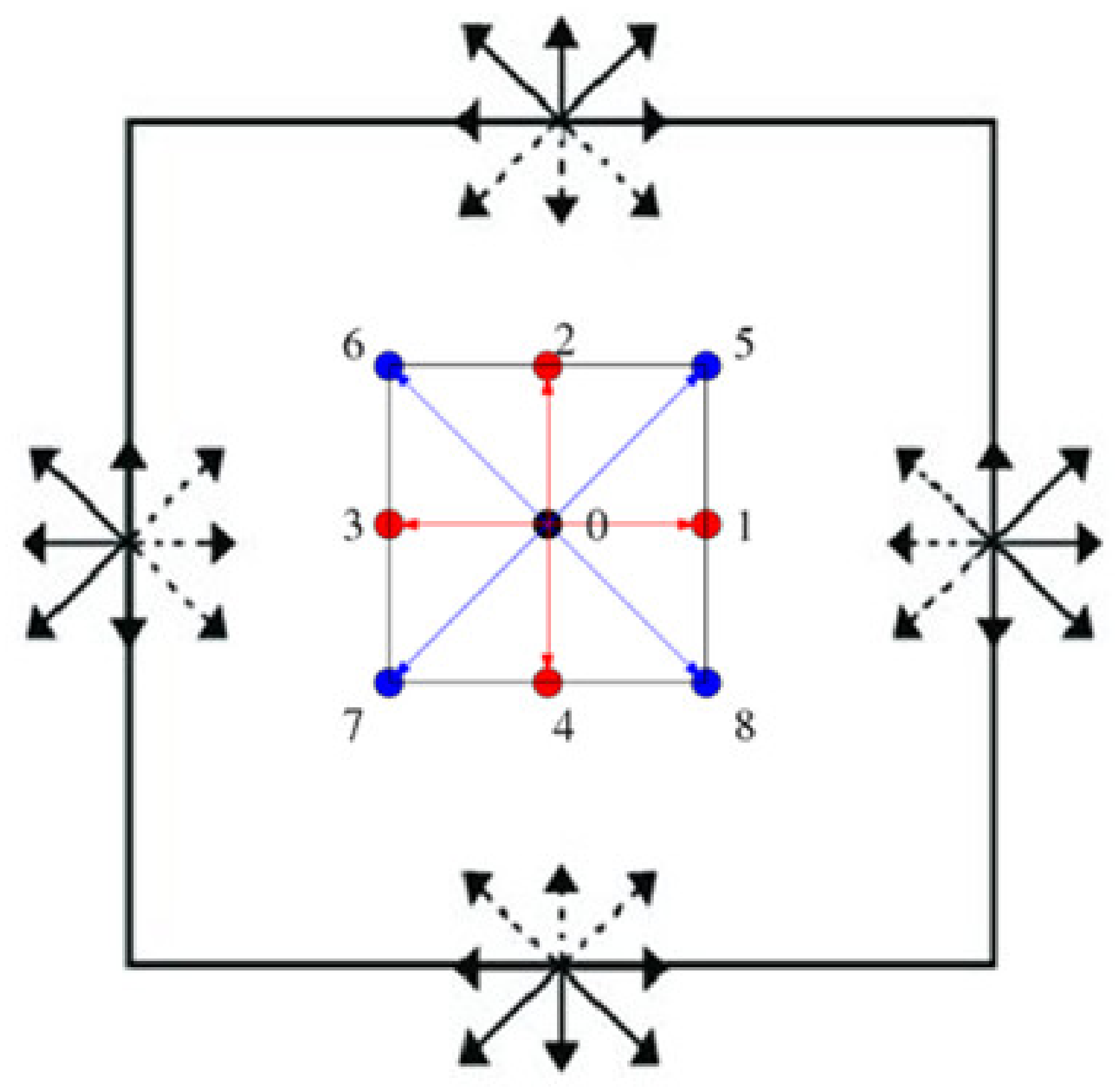
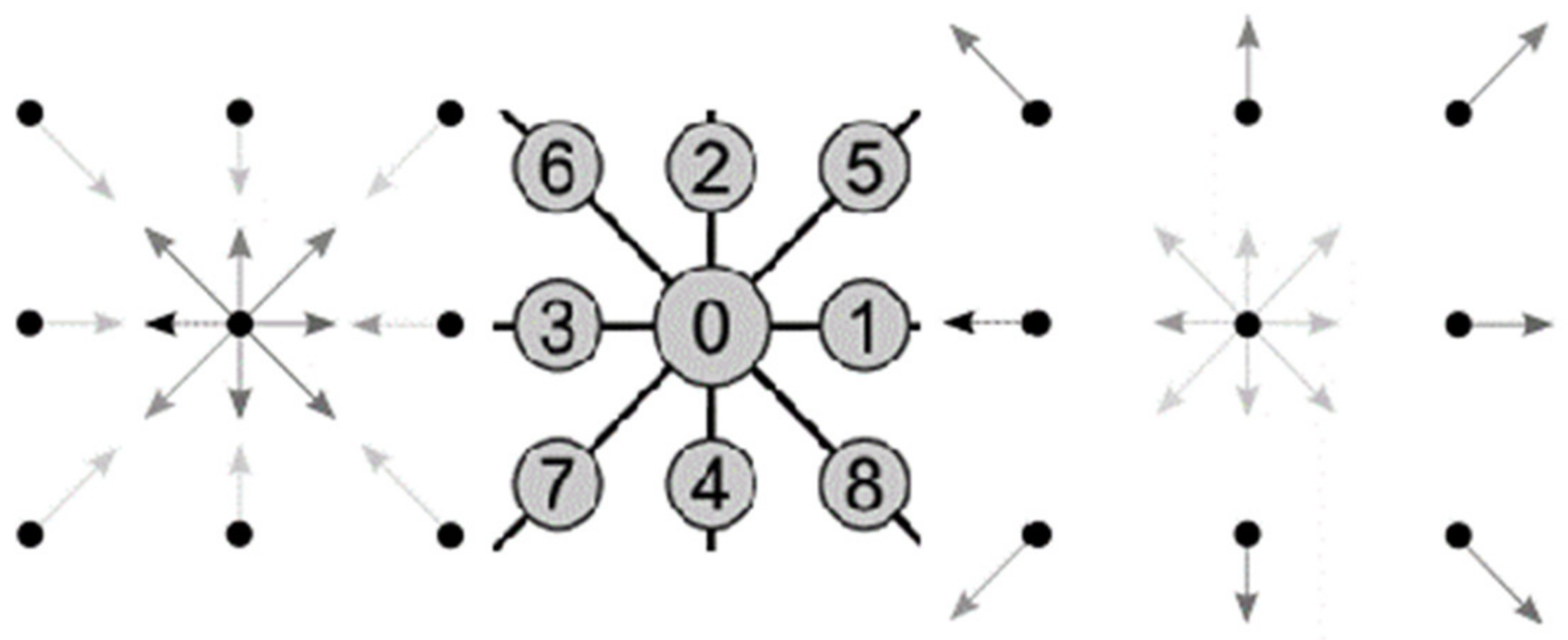

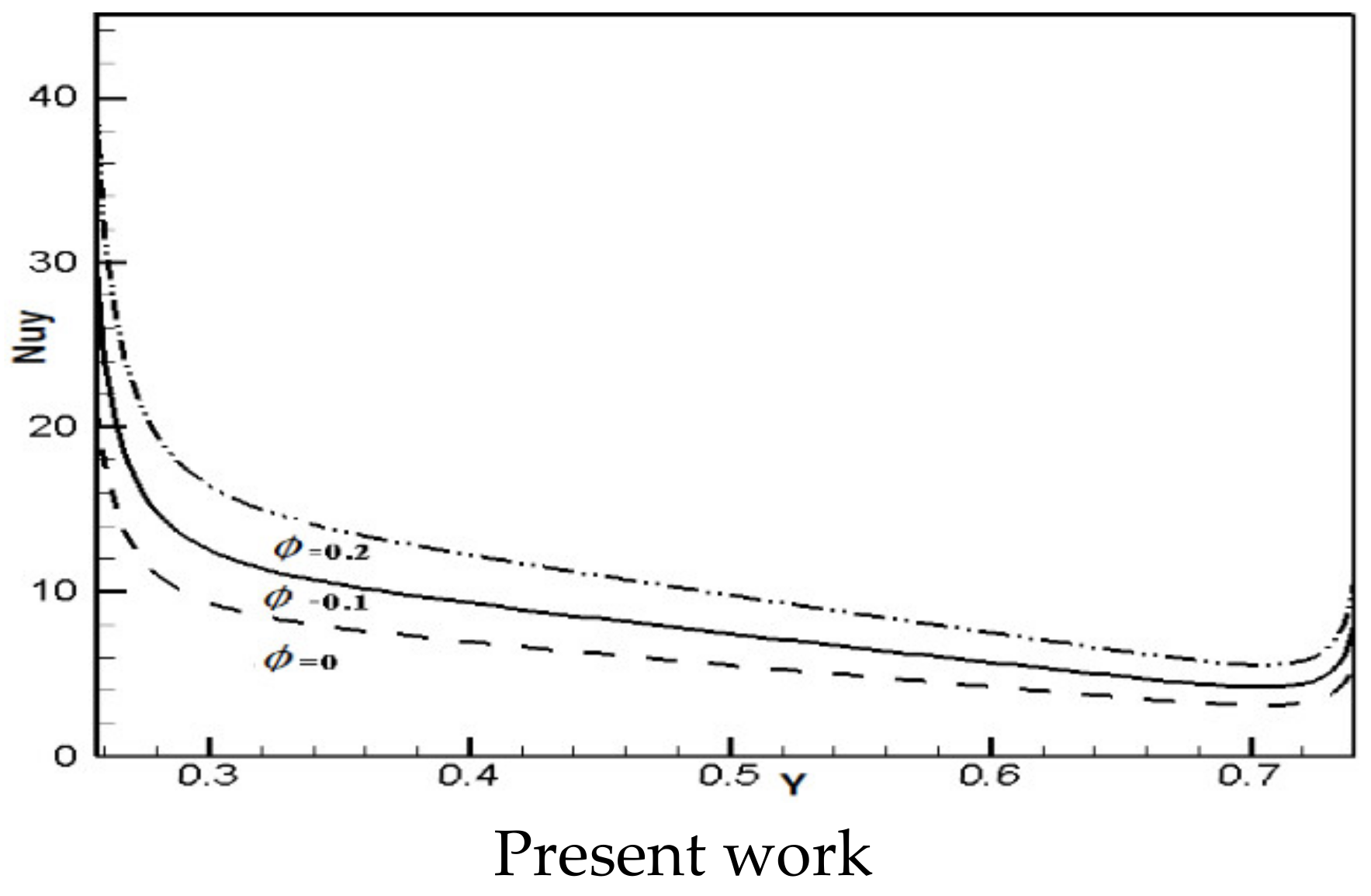
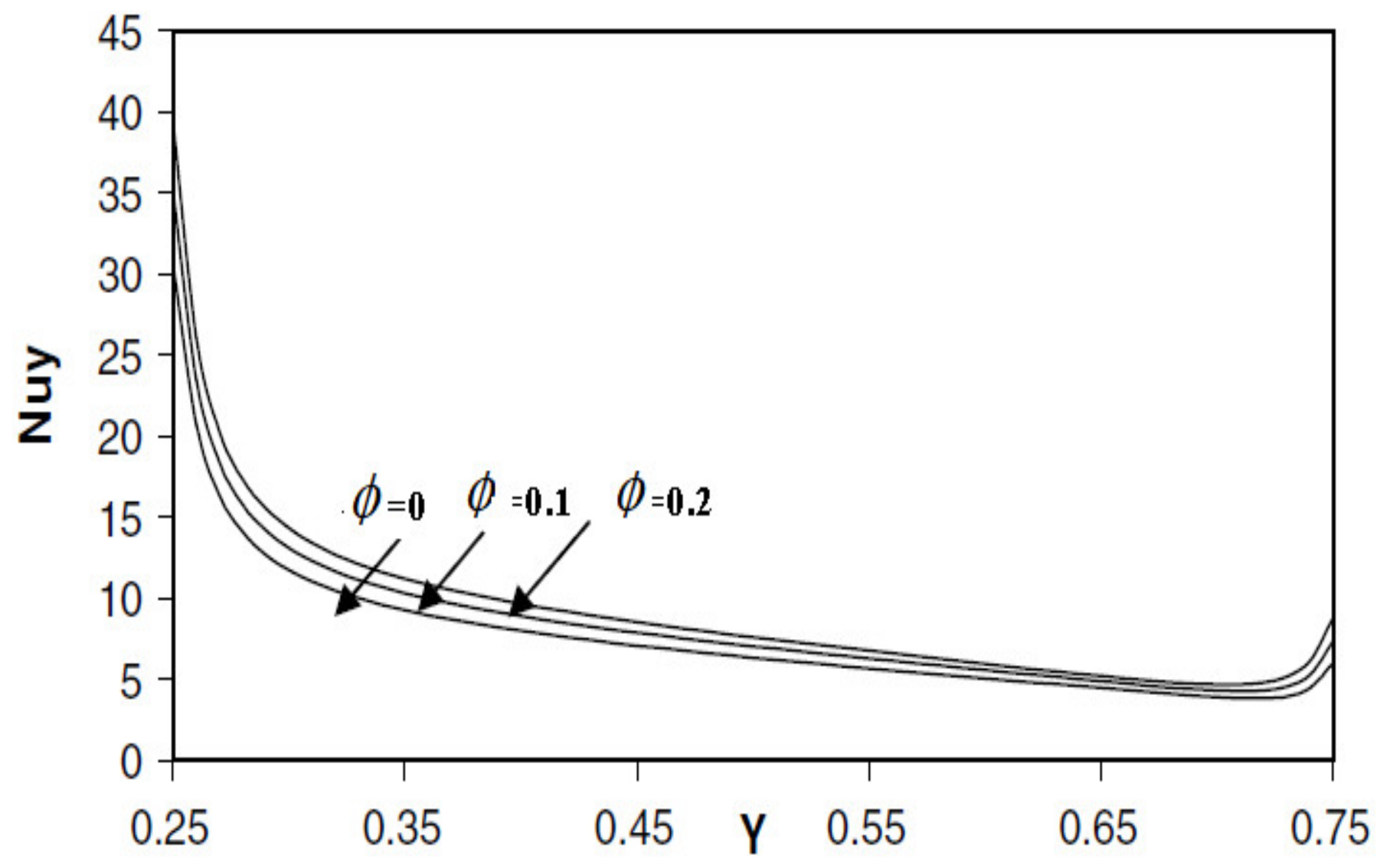

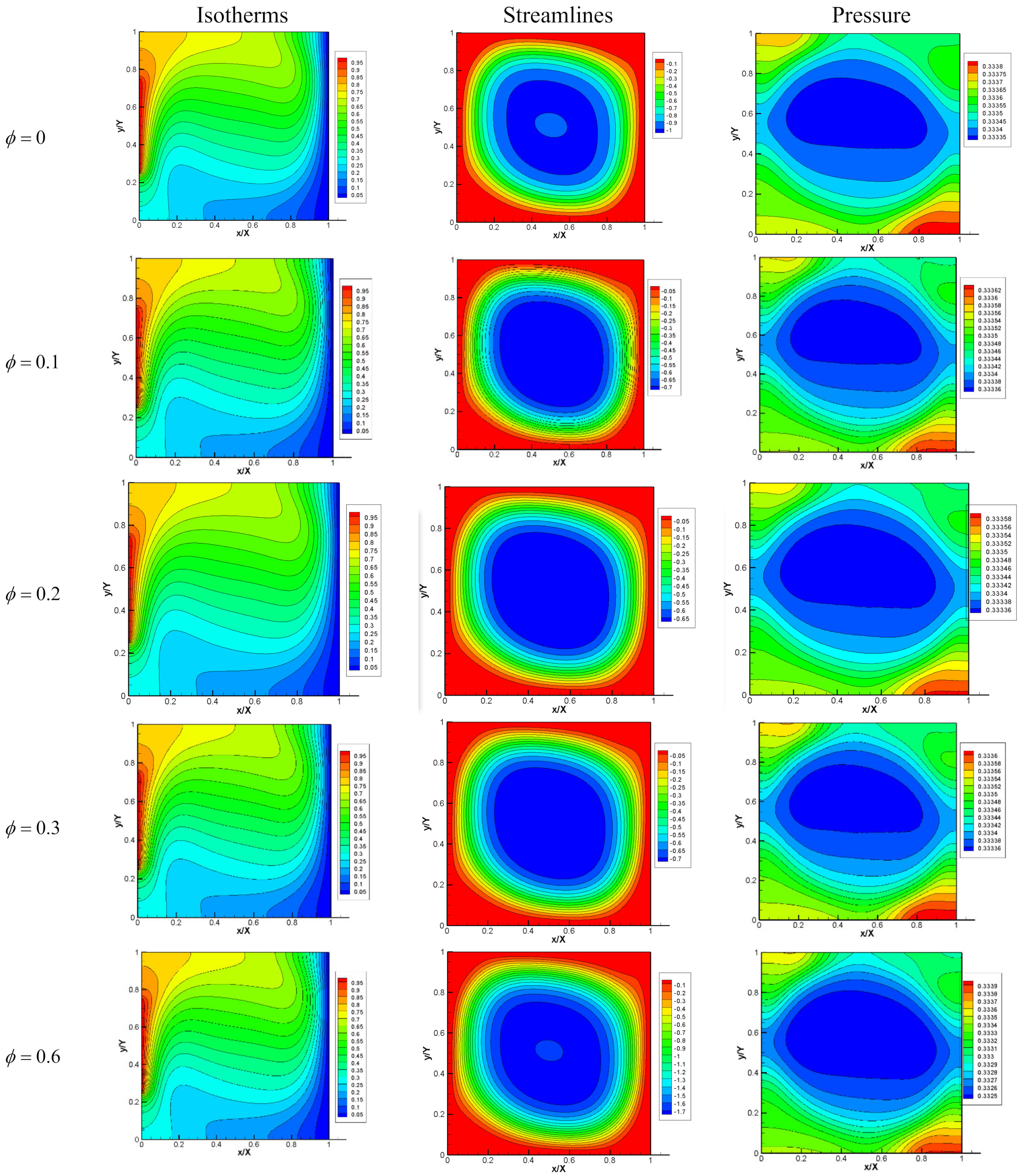
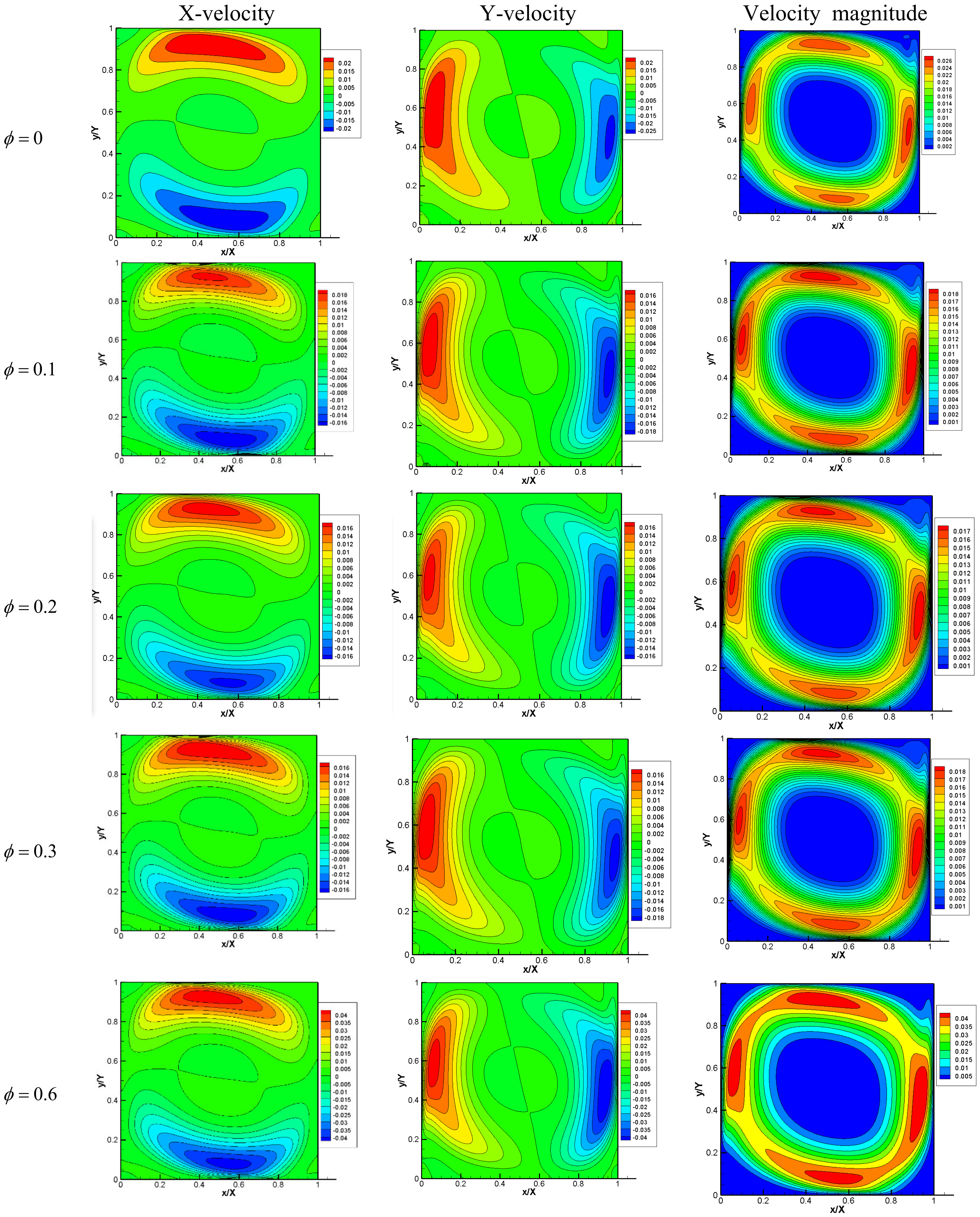
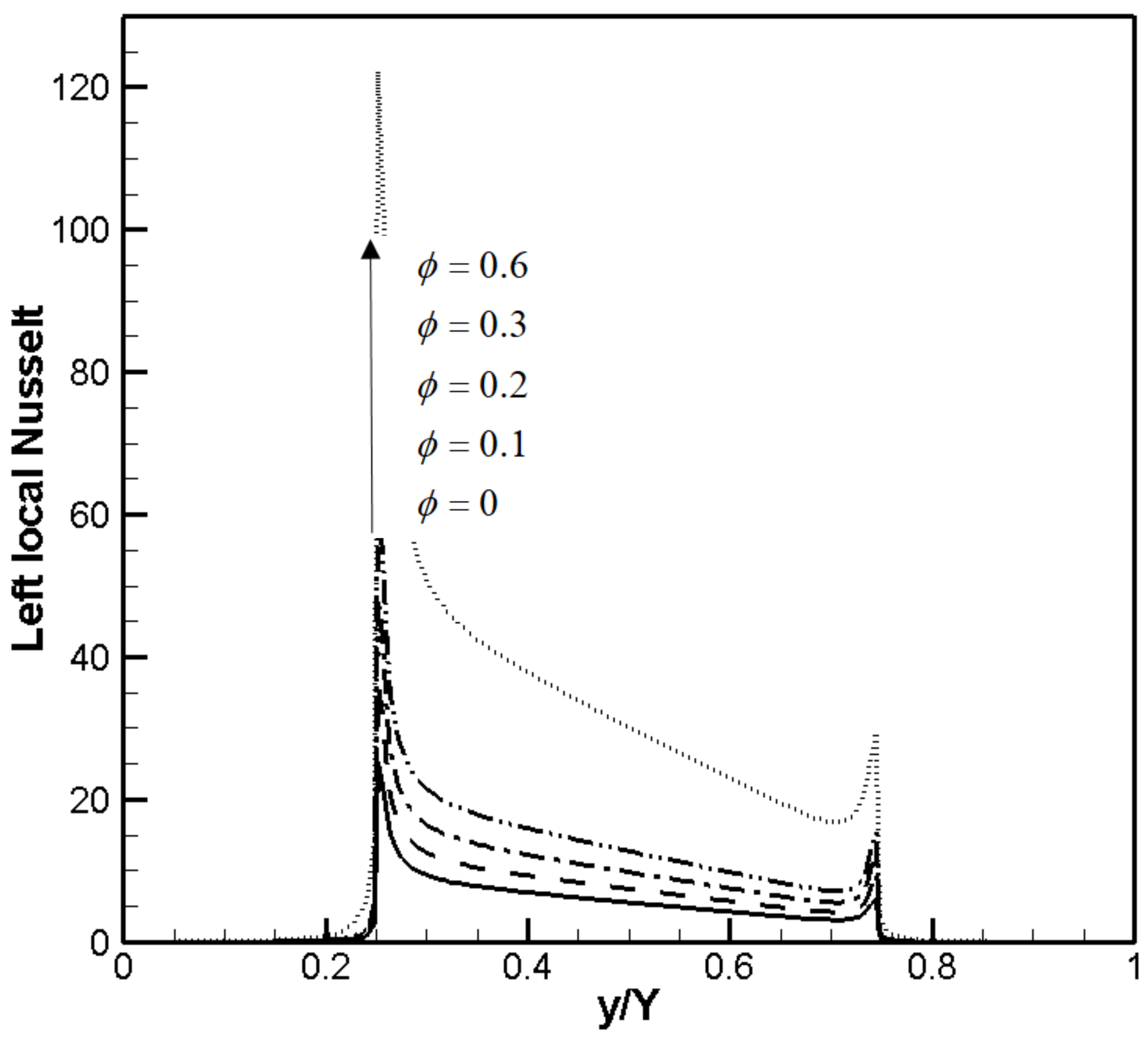
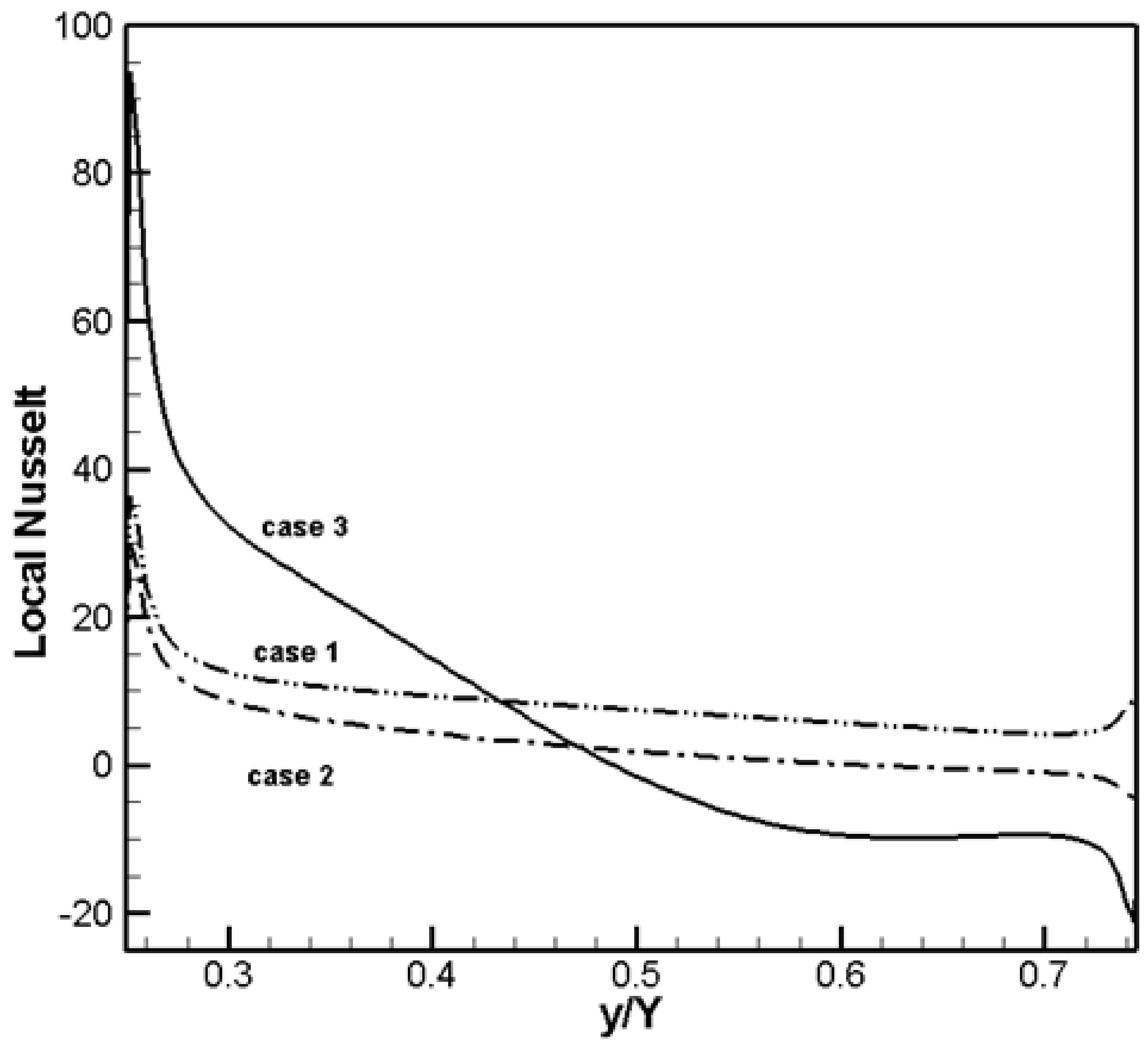
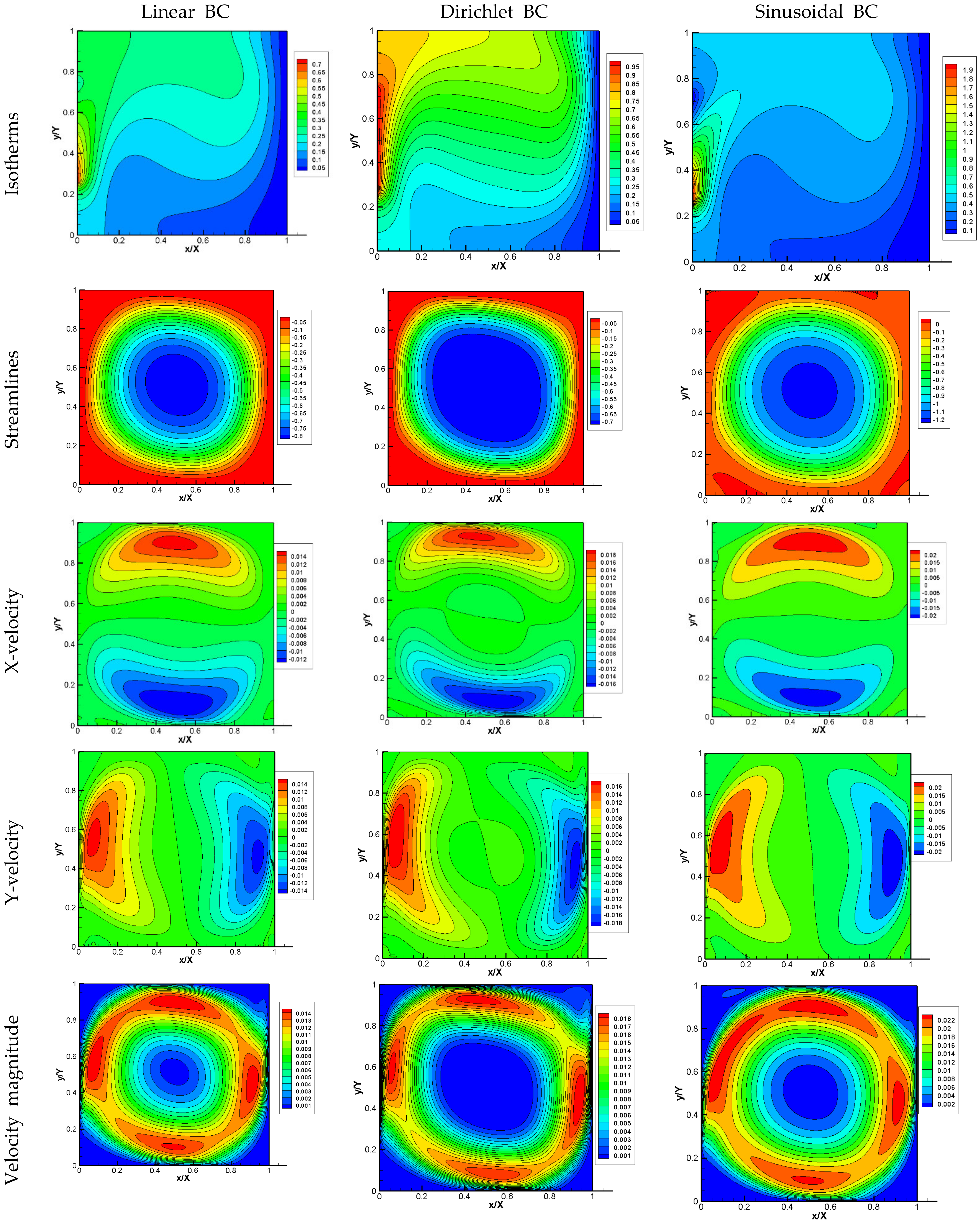

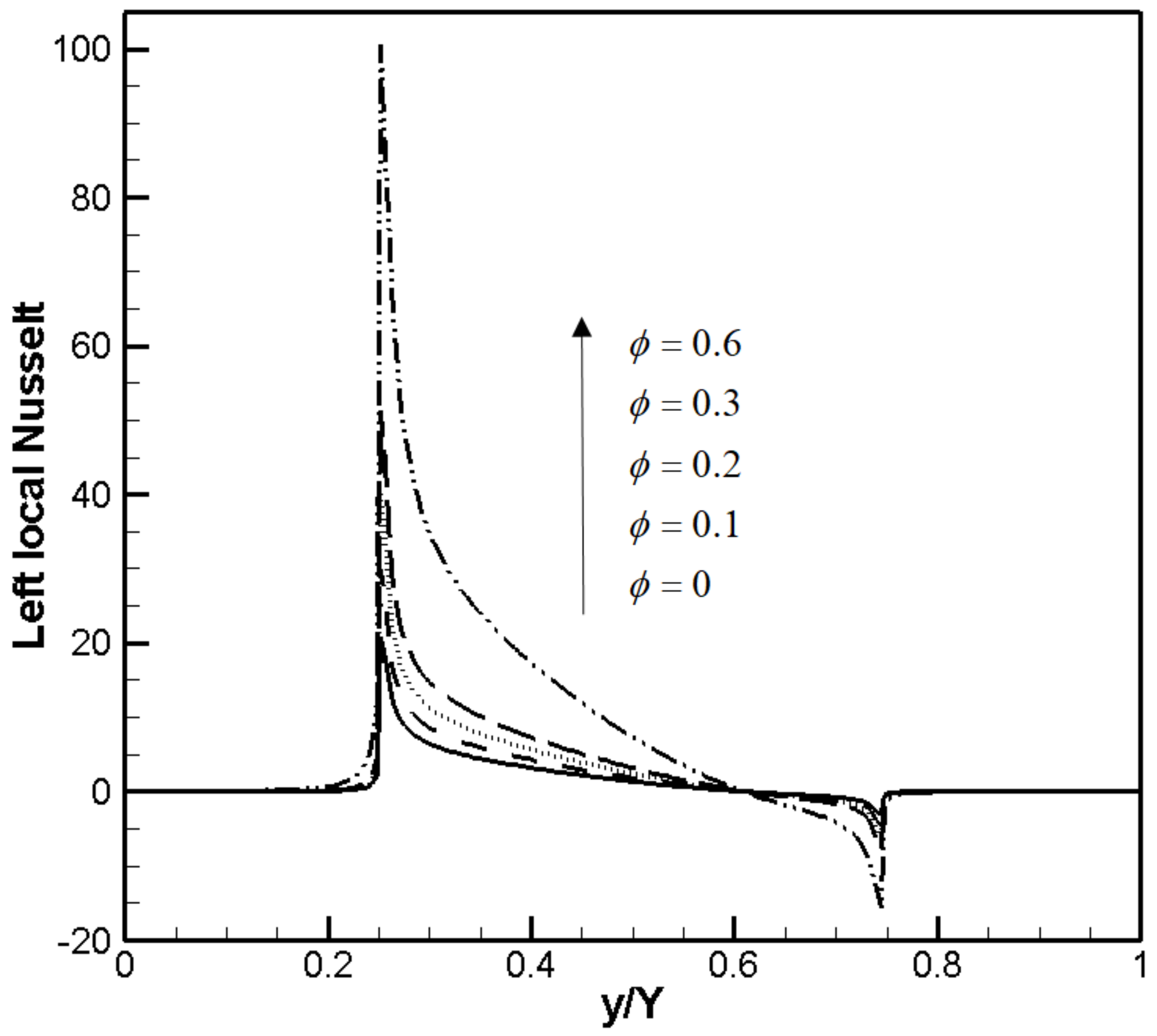
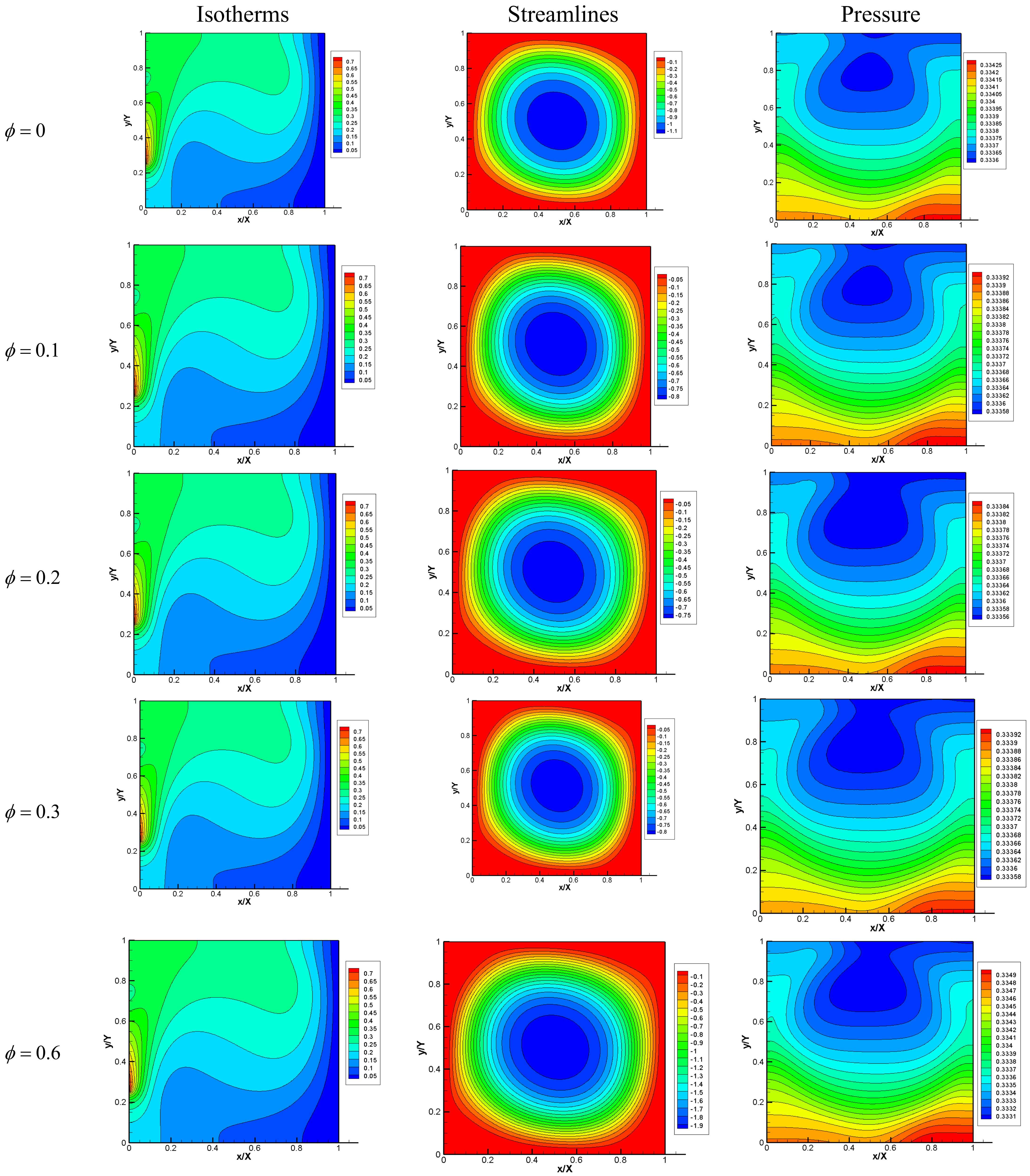





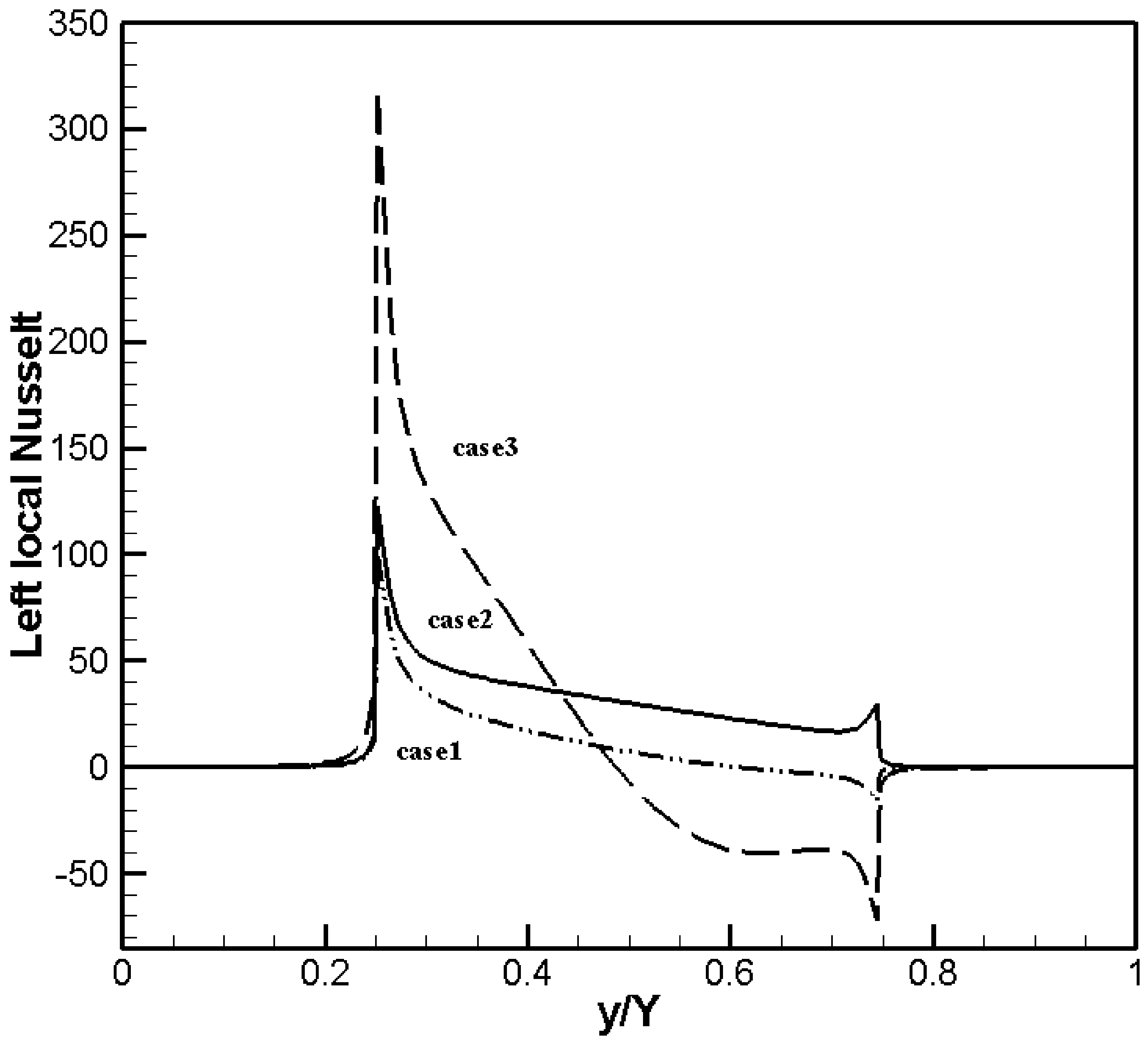
| Properties | Water Fluid Phase | Cu (Copper) Solid Phase |
|---|---|---|
| Cp (J/(kg·k)) | 4179 | 385 |
| Density (kg/m3) | 997.1 | 8933 |
| K (W/mK) | 0.613 | 401 |
| β × 105 (1/K) | 21 | 1.67 |
Publisher’s Note: MDPI stays neutral with regard to jurisdictional claims in published maps and institutional affiliations. |
© 2021 by the authors. Licensee MDPI, Basel, Switzerland. This article is an open access article distributed under the terms and conditions of the Creative Commons Attribution (CC BY) license (https://creativecommons.org/licenses/by/4.0/).
Share and Cite
Chaabane, R.; D’Orazio, A.; Jemni, A.; Karimipour, A.; Ranjbarzadeh, R. Convection Inside Nanofluid Cavity with Mixed Partially Boundary Conditions. Energies 2021, 14, 6448. https://doi.org/10.3390/en14206448
Chaabane R, D’Orazio A, Jemni A, Karimipour A, Ranjbarzadeh R. Convection Inside Nanofluid Cavity with Mixed Partially Boundary Conditions. Energies. 2021; 14(20):6448. https://doi.org/10.3390/en14206448
Chicago/Turabian StyleChaabane, Raoudha, Annunziata D’Orazio, Abdelmajid Jemni, Arash Karimipour, and Ramin Ranjbarzadeh. 2021. "Convection Inside Nanofluid Cavity with Mixed Partially Boundary Conditions" Energies 14, no. 20: 6448. https://doi.org/10.3390/en14206448
APA StyleChaabane, R., D’Orazio, A., Jemni, A., Karimipour, A., & Ranjbarzadeh, R. (2021). Convection Inside Nanofluid Cavity with Mixed Partially Boundary Conditions. Energies, 14(20), 6448. https://doi.org/10.3390/en14206448







